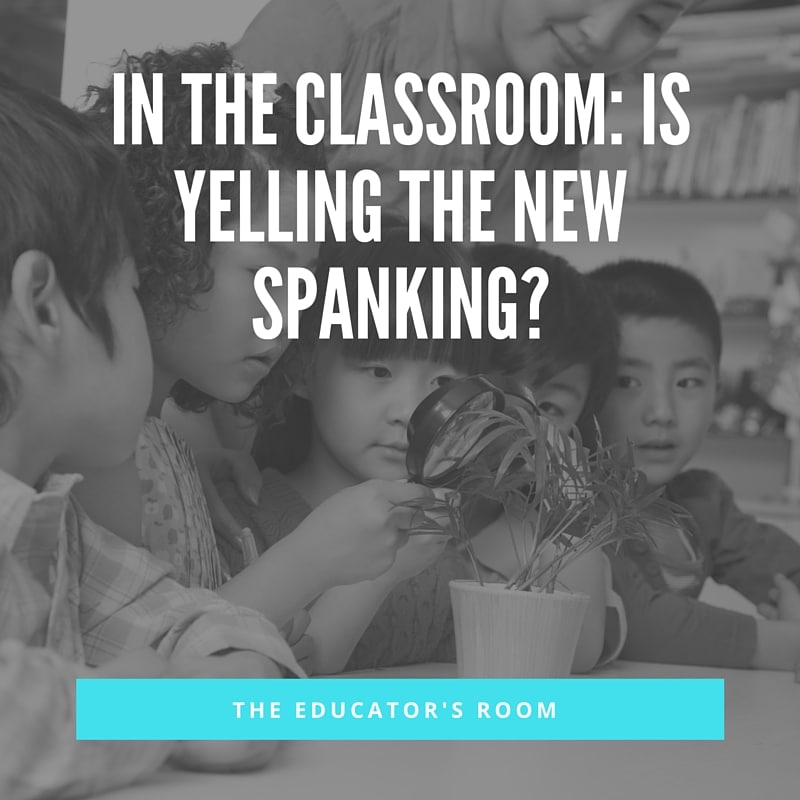Having gone to school in the seventies, I can easily look back upon my experiences in the public school system and compare them school system we view today; other than a building with teachers, I’m not sure one would even recognize the two entities side by side. One major difference is the form of classroom management; particularly the way schools administer punishment for misbehavior. Spanking and other forms of corporal punishment were very real techniques in the school system of the 70’s and before. Today schools have all but eliminated spanking as a form of corporal punishment, but many have come to ask the question, “Is yelling the new spanking?”
[fusion_builder_container hundred_percent=”yes” overflow=”visible”][fusion_builder_row][fusion_builder_column type=”1_1″ background_position=”left top” background_color=”” border_size=”” border_color=”” border_style=”solid” spacing=”yes” background_image=”” background_repeat=”no-repeat” padding=”” margin_top=”0px” margin_bottom=”0px” class=”” id=”” animation_type=”” animation_speed=”0.3″ animation_direction=”left” hide_on_mobile=”no” center_content=”no” min_height=”none”][bctt tweet=”Is yelling the new spanking?” username=”The Educator’s Room”]
We’ve all seen (or rather heard) teachers that consistently yell as a form of classroom management; it is their corporal punishment. When I was attempting to get my degree in my forties, I substituted in numerous schools for about three and a half years. Often the students would act up and I had to perfect my skills at managing a classroom and really learn to think on my feet. As I heard the “yelling teacher” down or across the hall, I would often wonder to myself if I weren’t doing something wrong. Maybe, after all, yelling was a very good tactic? One time I substituted in a “yelling teacher’s” classroom, and since the kids were used to being yelled at and seemed to need it, I decided to give it a try. I was instantly appalled. First of all, I didn’t like myself very much; it left me with sort of nasty taste in my mouth. Secondly, it didn’t work. I take that back, it did work for about half a minute, and then I would find myself needing to yell all over again. I was desperate. There had to be a better way of managing a classroom, and there was, I just had to discover it.
I did discover over time what worked in managing a classroom and what did not. You too have to discover what works and what does not. It requires the energy of a superhero, but with discipline (0n your own part) and persistence, you can run a classroom that’s devoid of the yelling tool, and here are some basic tips:
- Build a rapport with your students. The old adage, “Students don’t care what you know until they know you care,” goes a long way. If you build a relationship of respect that flows back and forth, you may find you have less discipline problems than most.
- Clearly define your expectations and rules. Chances are, on the first day of school, the rules that come out of your mouth are only half as important as your attitude and tone of voice. Let the students know that you are in control of your room and that you will hold them accountable to consistent expectations of behavior.
- Students need boundaries. A classroom out of control is not a happy classroom. No teacher is perfect, but let it be known that bullying and bad classroom behavior will not be tolerated.
- You will win. Student and teacher often come to the point where both realize that there can only be one winner in a battle for classroom control and one way or another, that winner will be you. Remember that you have many supporters in your school in the form of councilors, special educational teachers, principals, vice principals and more, use them.
- Students will love you, despite your disciplinary room. Students think that they don’t like rules, but in the end it’s the rules that make them feel safe and secure. Some of my students that required the most consistent discipline, are the ones that seemed to (in the end) “love” me the most.
I’m so very thankful that I work in a building full of people who are experts in classroom management, but perhaps you feel worn out and have resorted to becoming the frequent or occasional “yelling teacher”. Believe it or not, I’m here to tell you that it’s ok. It’s not ok to yell, but it’s ok to forgive yourself whenever you have. After all, teaching is a tough job, and if you are working long hours, perhaps didn’t get much sleep the night before or have a few personal problems at home, those can all add up to a weary, frazzled teacher that can perhaps once in a while “lose it” and resort to yelling. If you are, however, using yelling as a daily, habitual tactic, I’m here to tell you, that you are not doing yourself or your classroom a favor.
Although yelling is still a very real consideration for classroom management, don’t allow it to become the “new spanking.” It takes a lot of work to create a classroom that is well managed, but we all know that it is worth the investment. If you’ve pulled out the yelling tool to manage your classroom, just know you’re not alone, but avoid it at all costs. When all is said and done, yelling is a tool, but just know that it’s the least effective one you have.

[/fusion_builder_column][/fusion_builder_row][/fusion_builder_container]





Leave a comment